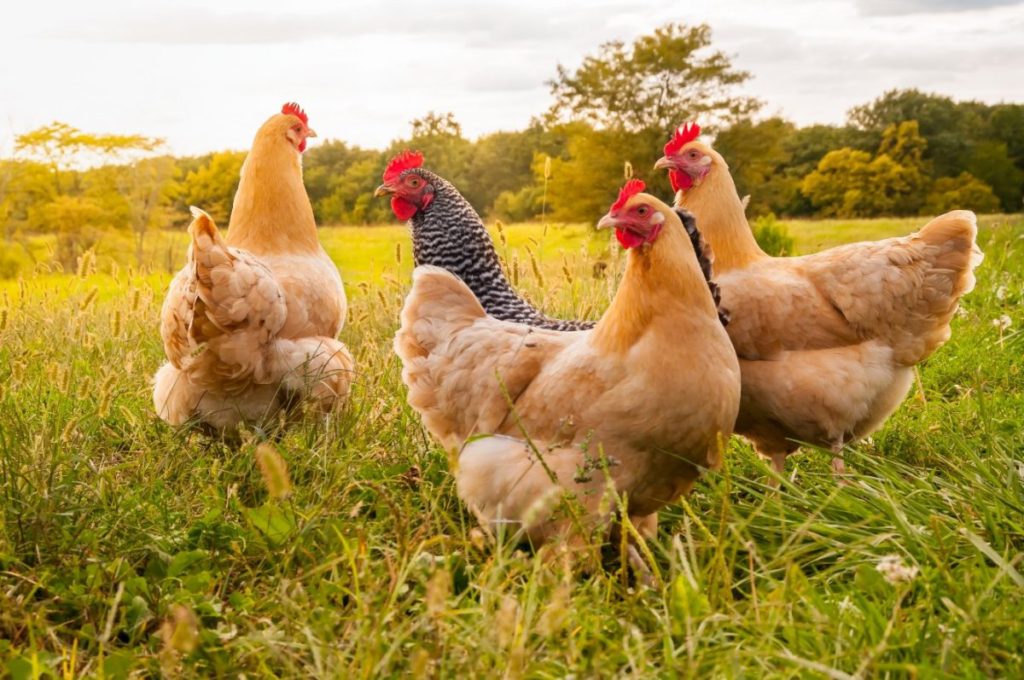September is National Chicken Month. (Celebrate?) See below for chicken books, chicken mummies, a dinosaur made from chicken bones, and Emily Dickinson’s opinion of why the chicken crossed the road.
Table of Contents
CHICKEN TALES
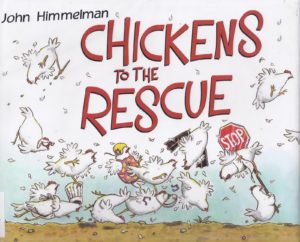
|
In John Himmelman’s hysterical Chickens to the Rescue (Henry Holt and Company, 2006), daily disasters – for example, when Farmer Greenstalk drops his watch down the well, Mrs. Greenstalk is too tired to cook dinner, or a duck steals the family truck – are expeditiously dealt with by a frenetic flock of chickens, who promptly rally round to the refrain of “Chickens to the rescue!” Except on Sunday, that is, the chickens’ day of rest, when it’s over to the pigs. Sequels include Pigs to the Rescue and Cows to the Rescue. For ages 3-6. |
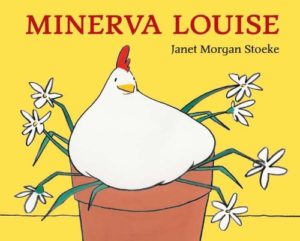
|
Janet Morgan Stoeke’s silly, but endearing, Minerva Louise (Dutton Juvenile, 1988) is the Amelia Bedelia of chickens, as she goofily wanders indoors and explores the farmhouse with the red curtains, mistakenly identifying the family cat as a friendly cow, a flowered bedspread as a meadow, a tricycle as a tractor, and a flowerpot as an easy chair. Several sequels. For ages 3-6. |
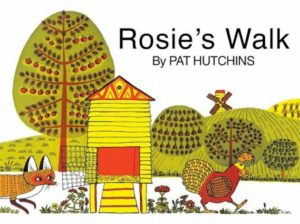
|
In Pat Hutchins’s Rosie’s Walk (Aladdin, 1971), Rosie – a red-and-yellow chicken – emerges from her coop and goes on a walk, oblivious to a pursuing fox whom she blithely causes to step on a rake, fall into a pond, smother in flour, and careen into a beehive. Finally, still happily clueless, she returns to her coop, just in time for dinner. For ages 3-6. |
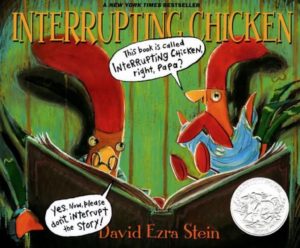
|
In David Ezra Stein’s Interrupting Chicken (Candlewick, 2010), a patient father rooster (in spectacles and carpet slippers) tucks his offspring, a little red chicken, into bed and attempts to read a bedtime story – only to be continually interrupted by his daughter, who can’t bear the suspense. “Out jumped a little red chicken,” she cries, as her father reaches a crucial point in Hansel and Gretel, “and she said ‘DON’T GO IN! SHE’S A WITCH!’ So Hansel and Gretel didn’t. THE END!” Finally the little red chicken embarks on a story of her own, only to be interrupted by her tired father’s snores. For ages 3-7.
Also see the sequel, Interrupting Chicken and the Elephant of Surprise (2018). |
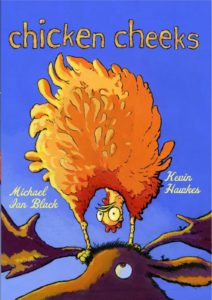
|
How many (reasonably polite) synonyms can you come up with for bottom, backside, and behind? In Michael Ian Black’s Chicken Cheeks (Simon & Schuster Books for Young Readers, 2009), a bear – determined to nab some distant honey – makes a teetery and improbable tower of animals, featuring views of their rear ends, among them a rhinoceros rump, polar bear derriere, moose caboose, and, of course, chicken cheeks. For ages 3-7. |
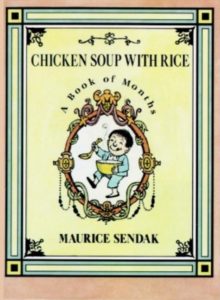
|
What better way to learn the months of the year than with Maurice Sendak’s Chicken Soup with Rice (HarperCollins, 1991)? (“In January it’s so nice/While slipping on the sliding ice/To sip hot chicken soup with rice.”) For ages 2-7. |
| A recipe for a yummy batch of chicken soup with rice can be found on the Food Network. (Sip it once, sip it twice.) | |
| Also see Soup (Poetic, Primordial, and More). | |
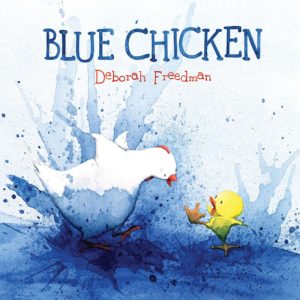
|
In Deborah Freedman’s Blue Chicken (Viking Juvenile, 2011), an artist is painting a barnyard scene when a curious little chicken hops out of the painting to help and tips over the artist’s pot of blue paint. Blue splatters across barnyard, animals, and pages, until finally the now-upset chicken washes it away by spilling the artist’s water jar. The illustrations are wonderful. For ages 4-7. |
| The Blue Hen Chicken is the official state bird of Delaware. Its story dates at least to the Revolutionary War. | |
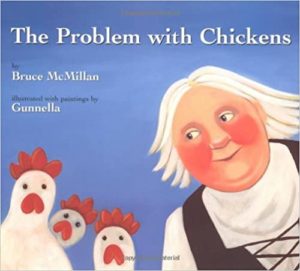
|
In Bruce McMillan’s delightfully illustrated The Problem with Chickens (HMH, 2005), set in a small town in Iceland, the chickens have stopped laying eggs. What to do? For ages 4-7. |
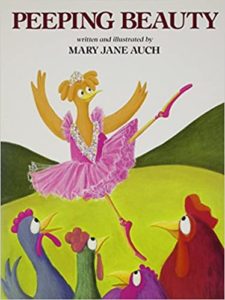
|
Author Mary Jane Auch must like chickens: her picture books are full of them. Peeping Beauty (Holiday House, 1995), for example, is the tale of Poulette, a graceful hen whose dreams of becoming a ballerina lead to a close call with a persuasive fox claiming to be a talent scout. Chickerella (Holiday House, 2006) is a fractured Cinderella tale involving glass eggs and a Fairy Goosemother; while Souperchicken (Holiday House, 2004) and The Plot Chickens (Holiday House, 2010) feature Henrietta, a bookish chicken who has taught herself to read, write, and type. For ages 4-8. |
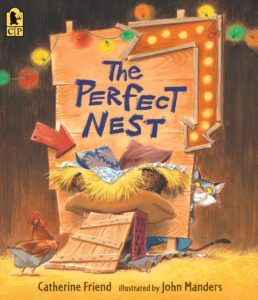
|
In Catherine Friend’s The Perfect Nest (Candlewick, 2007), Jack, a hungry cat, has built the perfect nest in an attempt to lure the perfect chicken to lay the perfect egg for an omelet. The ploy works too well, attracting not only a chicken, but a duck and goose – each of which lays an egg and then refuses to leave the nest, though Jack does his best to scare them off, with cries of “Flood!” “Fire!” and “WOLF!” Finally he manages to evict his guests (with hints about an even better nest at a farm down the road), but by then, to his dismay, the eggs have hatched, producing a trio of fuzzy chicks, who promptly adopt Jack as their dad. The book ends with Jack and his new family peacefully asleep in what is, indeed, a perfect nest. For ages 4-8. |
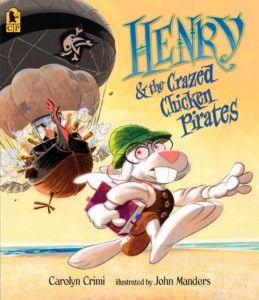
|
Carolyn Crimi’s Henry and the Crazed Chicken Pirates (Candlewick, 2010) stars Henry, the bookish son of Barnacle Black Ear, leader of the Buccaneer Bunnies and captain of the Salty Carrot. When Henry finds a threatening message in a bottle reading “We’re coming to steal all yer loot” and signed “yer worst enemies,” the buccanners refuse to pay attention. Henry, however, worried, begins to research and write a book: Henry’s Plan for Impending Danger from Unknown Enemy Who Wrote the Scary Note. When the enemy proves to be the Crazed Chicken Pirates, who arrive in a hot-air balloon, Henry manages to save the day. For ages 4-8. |
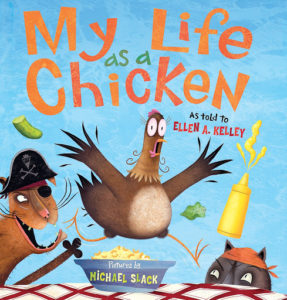
|
Ellen Kelley’s My Life as a Chicken (Harcourt Children’s Books, 2007) is a riotous account of the perils of Pauline Poulet (her motto: “Pauline, Prevail!”) who – after hearing the farmer planning a dinner of chicken pot pie – flies the coop. She ends up battling foxes, hungry hawks, and cat pirates, before finally, happily, finding a new home in a petting zoo. For ages 5-8. |
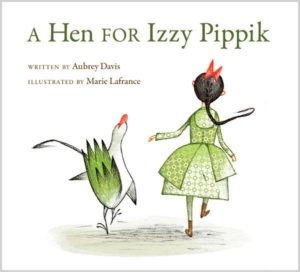
|
In Aubrey Davis’s A Hen for Izzy Pippik (Kids Can Press, 2012), Shaina finds Yevka, a spectacular hen with gold-speckled emerald feathers. Her hungry family wants to eat Yevka, but Shaina insists that the hen be returned to its rightful (absent) owner, Izzy Pippik. By the time Pippik returns to town, Yevka’s many chicks have overrun everything in sight, infuriating the townspeople – until they realize that the green-feathered chickens are attracting visitors and bringing prosperity. The generous Pippik rewards Shaina’s honesty by allowing the townspeople to keep them. For ages 5-8. |
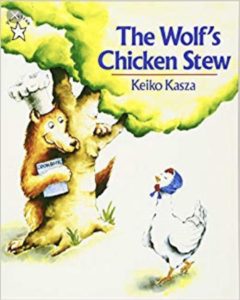
|
In Keiko Kasza’s The Wolf’s Chicken Stew (Puffin, 1996), Wolf decides to fatten up a chicken – his prospective future meal – by delivering piles of goodies to her doorstep: 100 pancakes the first night, then 100 donuts, and finally a 100-pound cake. When the Wolf arrives at the door to claim his fattened chicken, he finds that she’s been feeding an enormous family of baby chicks, who pounce upon him gratefully with cries of “Uncle Wolf!” The wolf, won over, heads home to plan a new treat for tomorrow. For ages 4-8. |
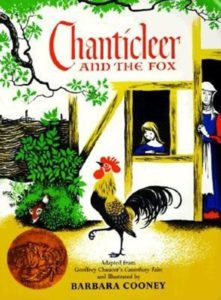
|
Chanticleer and the Fox (HarperCollins, 1982), with illustrations by Barbara Cooney, is a picture-book version of Chaucer’s “Nun’s Priest’s Tale” in which a wily fox (almost) tricks a conceited rooster. For ages 4-8. Also see Helen Ward’s The Rooster and the Fox (Millbrook Press, 2003). |
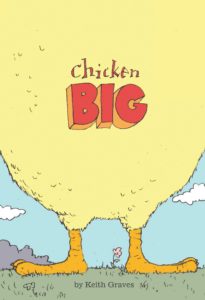
|
In Keith Graves’s Chicken Big (Chronicle Books, 2010), set on a teeny little farm populated by very small hens, a simply enormous egg hatches out a humongous yellow chick. “It’s an elephant!” squawks the smallest chicken. “Indoor elephants are dangerous!” The story has wacky elements of “Chicken Little” and “The Blind Men and the Elephant,” and a warm charm all its own, as eventually the patient, kindly, and gigantic chick convinces his freaky flock that he is indeed a chicken. For ages 4-8. |
| Listen to NPR’s Scott Simon and author Daniel Pinkwater read Chicken Big. | |
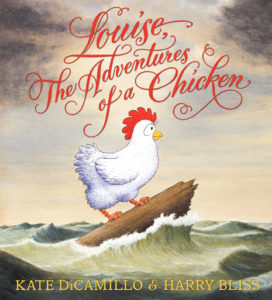
|
In Kate DiCamillo’s Louise, the Adventures of a Chicken (HarperCollins, 2008), brave Louise – a “not-so-chicken chicken” – survives pirates on the high seas, a high-wire walk and a chicken-eating circus lion, and an ominous dark stranger in a foreign bazaar, finally returning home to entertain her coopmates with stories of her exploits. A short chapter book for ages 4-8, with illustrations by Harry Bliss. |
| Louise, The Adventures of a Chicken has creative activities to accompany the book, among them inventing (and illustrating) adventures for a traveling pet (stuffed animal), writing an animal adventure book, or re-writing the adventures of Louise. | |
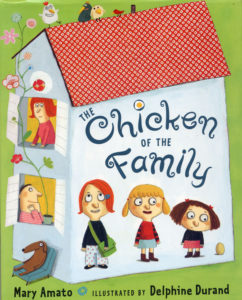
|
In Mary Amato’s The Chicken of the Family (Putnam Juvenile Books, 2008), Henrietta’s teasing big sisters Kim and Clare tell her a secret – she’s really a chicken. (“Mom got you from Barney’s farm.”) Henrietta, upset, is finally convinced, and heads off for Barney’s farm – where she finds that the chickens are much nicer to her than her big sisters are. Now Kim and Clare are hard put to persuade Henrietta that she’s a little girl again. Funny, charming, and there’s a lesson here about the perils of teasing. (Younger siblings especially will love it.) For ages 4-8. |
| This Chicken of the Family Reader’s Theater script calls for five characters plus any number of supporting chickens. | |
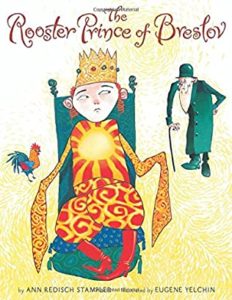
|
Ann Redisch Stampler’s The Rooster Prince of Breslov (Clarion Books, 2010) is a retelling of a traditional Jewish folktale about a prince who suddenly tears off his clothes, squawks and clucks, and insists that he’s a rooster. A wise old man – willing to pretend to be a rooster too – finally convinces the prince to become a human being again. For ages 5-9. |
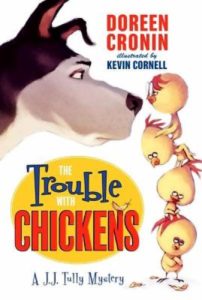
|
In Doreen Cronin’s The Trouble with Chickens (Balzer + Bray, 2012), J.J. Tully, retired search-and-rescue dog, is approached by a chicken who needs helps in finding two missing chicks. Funny, clever, and narrated in the first person by J.J., who sounds a bit like Sam Spade. The first of a series. For ages 6 and up. |
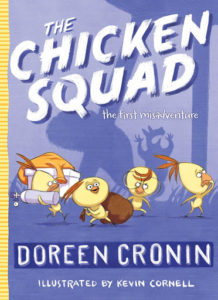 |
Doreen Cronin’s hilarious The Chicken Squad: The First Misadventure (Atheneum, 2015) is the first of a series starring the crime-fighting Chicken Squad (Dirt, Sugar, Poppy, and Sweetie). This misadventure begins with a scatty and terrified squirrel. For ages 6-10. |
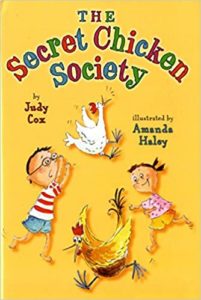
|
In Judy Cox’s The Secret Chicken Society (Holiday House, 2012), Daniel’s third-grade class hatches chicken eggs, and Daniel ends up with five chicks to take home – including his special favorite, Peepers. Chick care turns out to be challenging, and even illegal, when Peepers turns out to be a rooster, forbidden within the city limits. A funny, chicken-friendly, (and informational) chapter book for ages 6-10. |
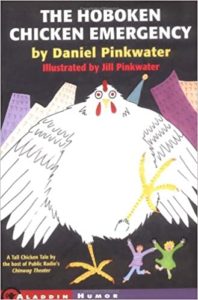 |
In Daniel Pinkwater’s hilarious The Hoboken Chicken Emergency (Aladdin, 2007), Arthur Bobowicz is dispatched to fetch the family Thanksgiving turkey, but returns home instead with Henrietta, a colossal 266-pound chicken on a leash – who escapes and wreaks havoc. For ages 7-11. |
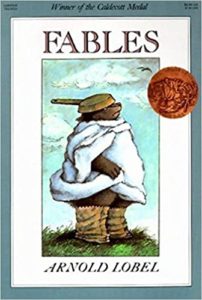
|
Arnold Lobel’s cleverly illustrated Fables (HarperCollins, 1983) is a collection of twenty one-page original fables, each with an accompanying helpful moral. (“It is always difficult to pose as something one is not.” “It is the high and mighty who have the longest distance to fall.”) Two of the stories involve chickens: “The Hen and the Apple Tree” and “The Young Rooster.” For ages 7-11. |
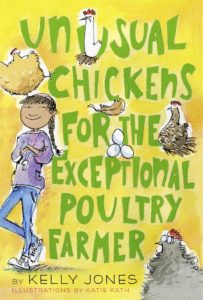
|
In Kelly Jones’s Unusual Chickens for the Exceptional Poultry Farmer (Yearling, 2016), Sophie’s family has just inherited a great-uncle’s farm – where Sophie discovers his flock of extraordinary chickens with superpowers. The story is told through letters, to-do lists, newspaper articles, a chicken-care correspondence course, and more. Funny and absolutely delightful for ages 8-12. |
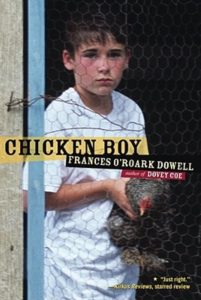
|
In Frances O’Roark Dowell’s Chicken Boy (Atheneum Books for Young Readers, 2008), seventh-grader Tobin McCauley has a lot on his plate: juvenile-delinquent siblings, a neglectful father, a dead mother, and a grandmother in jail. Then he becomes friends with Henry Otis, the new kid in town, and embarks on a chicken-raising project – “When you learn about chickens, you will learn about life,” says Henry – that ultimately leads to family reunion and self-discovery. For ages 10-14. |
